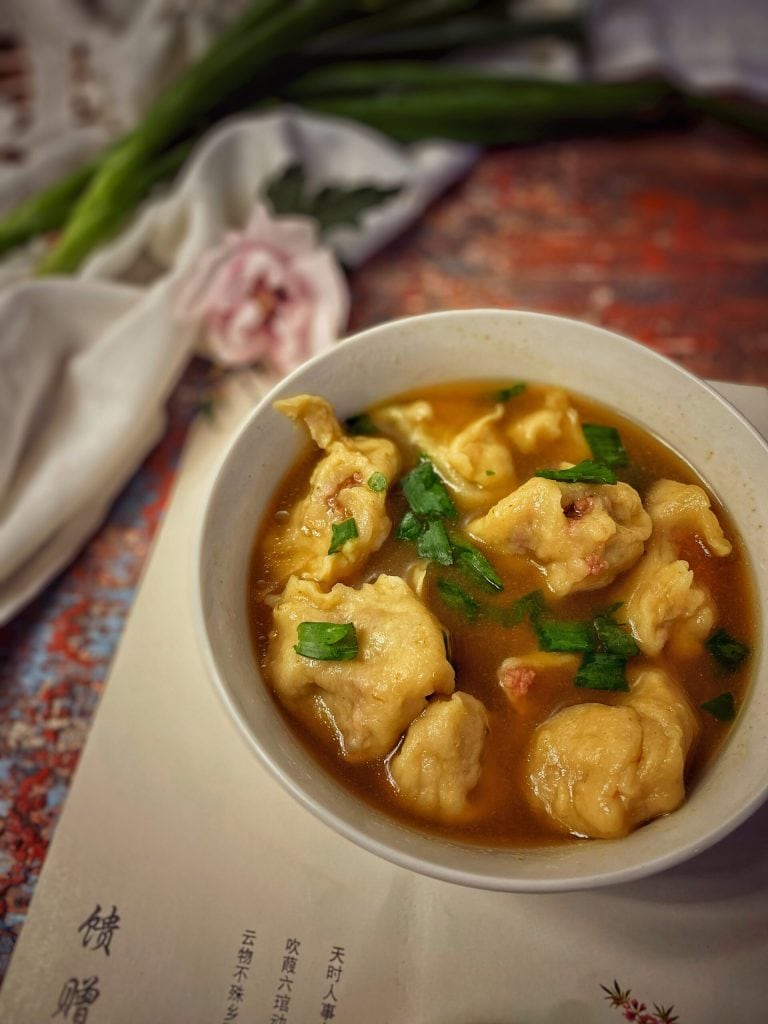The wonton (traditional Chinese: 餛飩) is a type of Chinese dumpling commonly found in regional Chinese culinary styles.
It is also written as Wantan or Wuntun in Cantonese transliteration (雲吞/云吞, wan4 tan1) and wenden in Shanghainese (餛飩/馄饨, hhun den).
Although there are many different styles of wonton served throughout China, Cantonese wontons are the most popular in the West due to the predominance of Cantonese restaurants abroad.
They are prepared by placing a square wrapper (a sheet of dough made from flour, eggs, water, and salt) flat on the palm, placing a small amount of filling in the center, and sealing the wonton into the desired shape by pinching the wrapper edges together with the fingers.
The most common filling is ground pork or chicken and shrimp with a small amount of flour added as a binder.
The mixture is seasoned with salt, spices, and often finely chopped garlic or scallion.
Commonly, they are boiled and served in soup, and sometimes fried.
There are several common regional shape variations, from the simple right triangle formed by folding the square wrapper in half diagonally to the globular form made by pinching all four corners together.

- Difficulty: Medium
- Cost: Economical
- Preparation time: 10 Minutes
- Portions: 6 People
- Cooking methods: Boiling
- Cuisine: Chinese
- Seasonality: All seasons
Ingredients
- 30 wonton wrappers
- 9 oz ground pork
- 4 scallions
- 1 1/2 teaspoon cornstarch
- 1 liter chicken broth
- to taste ginger (fresh and ground)
- 3 tablespoons soy sauce
- to taste sesame oil
Steps
For the preparation of the “wonton skin“, follow the recipe for Siomay.
For the filling: in a large bowl, mix the pork, 2 finely chopped scallions, 1 tablespoon of soy sauce, 1 teaspoon of sesame oil, grated ginger, and cornstarch.
Preparation:
Place a teaspoon of filling in the center. Do not overfill.
Moisten the edges with a few drops of water.
Fold into triangles, pressing the edges into a tight seal.
Pinch the two edges of the triangle together and seal with a bit of water.The soup: in a large pot, add the broth, garlic, scallions, sliced ginger, soy sauce, and sesame oil.
Bring to a boil over medium-high heat, reduce to a simmer, and cook uncovered for 10 minutes.
Remove the garlic and ginger.Add the wontons to the soup and simmer for another 4-6 minutes or until the pork is cooked through. Serve immediately.

FAQ (Frequently Asked Questions)
What is the difference between Wonton and Jiaozi?
Wontons resemble jiaozi (餃子) but usually have less filling and are wrapped in a thin yellow square wrapper of 2.36 × 2.36 inches or in an isosceles trapezoid and folded into a triangle shape reminiscent of a Chinese gold ingot known as yuanbao (元寶).
Jiaozi are wrapped in a slightly thicker circular white wrapper with more filling and flat or crimped edges.
The wonton wrapper is sometimes called “wonton skin” and becomes transparent after being fully boiled.
The round-shaped wrapper is typically used for Siomai or Gyoza, while the square one is for Molo or Wonton.
It takes less time to boil a wonton. The texture is also very smooth.
And they are traditionally served in soup, while jiaozi is usually eaten with sauce.How are Wontons served in Cantonese cuisine?
In Cantonese cuisine, wontons stuffed with shrimp inside ground pork are most commonly served with thin noodles in a steaming hot soup to make wonton noodles.
They can also be eaten with red vinegar.
The soup is made from boiled shrimp shells, pork bones, and dried sole to impart a distinct taste.How are Wontons served outside China?
In American Chinese cuisine (and occasionally in Canada), wontons are served in two ways: in wonton soup (wontons in a clear broth) and as an appetizer called fried wonton.
The fried wonton is made with a meat filling (usually pork) and eaten with duck sauce, plum sauce, sweet and sour sauce, or hot mustard.
The version filled with cream cheese and crab is called crab rangoon.
Another version is filled with cream cheese, green onions, soy sauce, and garlic.
Wonton strips or deep-fried strips made from wonton wrappers and served with hot mustard or other sauce are a common free appetizer in American-style Chinese restaurants.
In the Philippines, fried wontons are often referred to as pinseques frito. They are also featured in the noodle soup pancit Molo, named after the Molo district of Iloilo City.
The wonton wrappers in the broth serve as noodles in the dish.
They are commonly eaten in Singapore as part of the country’s hawker culture, eaten with noodles and called dry wonton mee.
In Indonesian Chinese cuisine they are called pangsit and are served fried or in soup, usually with Chinese noodles.
In the Peruvian-Chinese culinary fusion called Chifa, they are called Wantán and can be found fried with meat filling to be eaten with rice or Tallarín saltado, or even in wonton soup or sopa Wantán.
In Thailand they are called kiao (เกี๊ยว, pronounced [kía̯w]), from the Teochew pronunciation of 饺 (Mandarin: jiǎo; “dumpling”).
Wonton soup is called kiao nam (เกี๊ยวน้ำ, [kía̯w náːm]) made with chicken broth.
In Eastern Europe, mainly in Russia (where they are called пельмени pelmenyi) and Estonia (where they are called pelmeenid), they are usually filled with minced meat, boiled or fried; many people eat them with vinegar and sour cream.
In Vietnamese cuisine they are known as hoành thán.

